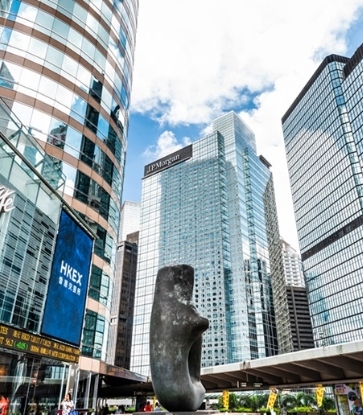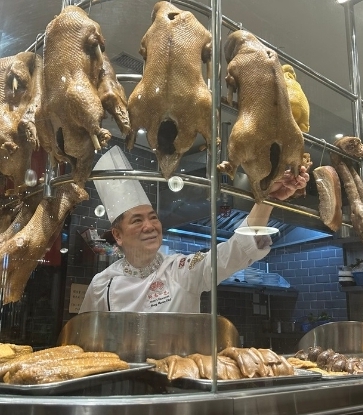Chocolate is loved by people from all over the world in various forms. With a history of over 4,000 years, chocolate is derived from the fruit of theobroma cacao, a tropical tree commonly found in South American whose name means "food of the gods" in Greek.
Synonymous with indulgence, among chocolate's many endearing qualities is its versatility, making it one of the most coveted ingredients used by top chefs around the world. In celebration of World Chocolate Day, we ask Hong Kong’s MICHELIN pastry chefs about their most artful creations—and adventurous experiments—with this remarkable ingredient.

Mandy Siu
Pastry chef of two-MICHELIN-starred L’Envol
Passionate about pastries since the age of 15, Mandy Siu has no creative boundaries when it comes to her sweet creations.
The pastry chef of L’Envol has a personal preference for intense and fruity chocolates, which are well represented in her creations. “I like Valrhona’s INSPIRATION range of fruit couvertures, such as the yuzu and raspberry innovation. They boast the right amount of fruitiness and sourness that can be fully expressed in my fruit desserts in the form of mousse, ganache, or chocolate decorations.
Her most adventurous chocolate creation to date, however, will take you by surprise. “I’ve tried to create a dessert inspired by cigar and cognac. Since cognac tends to be the beverage of choice when people smoke a cigar, I had the idea of infusing real tobacco leaf with cream and making a smoked ganache! It was an experiment, but I realised that it wasn’t suitable for direct consumption as the fermentation process develops a strong chemical flavour.”
It’s no exaggeration to say that Siu’s specialty is creating works of art on the plate. Her “Le Chocolat, Shock-O-Lat”, shaped like a blooming sunflower, is nothing short of Instagrammable. “I use sugar and dark chocolate to make a light and crispy sugar tuile that curls beautifully and resembles the shape of sunflower petals. It’s truly delicate and it takes a lot of time to make. The sphere is filled with a Carupano 62% chocolate mousse, sitting on a bed of muscovado crumble complete with a shiny chocolate glaze that fills half of the plate.”

Natalie Leung
Pastry chef of one-MICHELIN-starred Louise
At Louise, chocolate desserts are taken seriously. Whether it’s a decadent chocolate tart or cheeky profiteroles, creating chocolate desserts is a balancing act of flavour and presentation in the pastry kitchen.
Take the Chocolate Grand Cru, an assemblage of multiple textures and temperatures. “Chocolate’s versatility plays a vital role in this dessert. The base is made of a chocolate and hazelnut tart shell which uses the same Valrhona Jivara 45% as the whipped ganache. At the top, we create an aerated chocolate using a vacuum technique, juxtaposing the crunchiness with an airy chocolate seafoam sponge. It is served with a sorbet on the side and a hot chocolate foam to create a contrast in temperature,” says Leung.
For the Hong Kong native, it is the therapeutic factor of making chocolate desserts that keeps her inspired in the kitchen. “I find working with chocolate peaceful. When I make chocolate bonbons, for example, I enjoy the time it takes to temper the chocolate by hand—it’s so relaxing. Many find making chocolate messy, but for me, it’s a form of meditation.”

Dafne Daniels
Chef de partie at MICHELIN Plate restaurant Mono
The creative process manifests in different ways. For Daniels, a Mexcian native who had her mind set on a career in architecture and design but followed her heart to study culinary arts, the kitchen is where her creativity shines through.
As the chef de partie of Mono, where the pod-to-plate ethos takes centre stage, Daniels works closely with the kitchen team to make chocolate from scratch. “The process is complex. From smashing the cacao beans to fermentation to roasting, there are many stages to create the chocolate we have at Mono,” she says. “It is a collaborative process that involves everyone from the sous chefs to the team at the hot section. The result is magnificent.”
Mono’s homemade chocolate has a cacao percentage of 70%, which embodies simplicity in the form of a ganache topped with cocoa nibs, Sicilian olive oil and rosemary ice cream. Describing cacao as “a humble ingredient”, Daniels also shares that every part of the cacao is utilised wherever possible. The fermented water from the pod is extracted to make a sorbet, the pulp of the beans is served as a jelly, and the skin of the pod makes a chicha, a traditional drink from Latin America.
“Working directly with chocolate at Mono has been a dream come true. As a Latin American, this is the closest I have been to cacao.”
RELEVANT: Ricardo Chaneton On His "Destiny" To Open Mono In Hong Kong

Julien Gourmelon
Executive pastry chef at one-MICHELIN-starred Petrus
Having grown up in a family of millers and chefs, Gourmelon has developed a passion for pastry since childhood. As a master chocolatier who has experimented with a diverse variety of chocolates, he enjoys working with single origin dark chocolates the most. “You can taste the terroir in each different origin,” he says.
On a quest for couverture chocolate, the French chef has attempted to make chocolate from scratch, from selecting the origin of the cacao beans to the percentage of cocoa. He shares his passion for chocolate with executive chef Uwe Opocensky, who encourages new combinations and ideas to create unconventional flavours. Opocensky’s current favourite is “chocolate whisky and salted caramel.”
“Chocolate is a language, a craft by itself. It is our role, as the middleman between the producer and consumer, to elevate the history and taste of chocolate,” says Opocensky.
RELEVANT: Petrus Chef Uwe Opocensky On Re-Inventing A Culinary Icon

Nocar Lo
Pastry chef of two-MICHELIN-starred Tate
For the Hong Kong-born pastry chef, chocolate is associated with happy memories and positive emotions. “It’s chocolate’s natural properties to make people feel happy,” says Lo. Her personal favourite is the 80% dark chocolate from Peru.
“It’s a rather complex chocolate, predominantly fruity with a smoky finish. It also goes well with spices, fruits and coffee. It’s just heaven in one bite—the essence of the bean, the soil and the sun are all expressed in a mouthful.”
For her desserts at Tate, Lo prefers to work with the 70% chocolate. “The oil content is higher which provides a smoother texture. It can also be heated quickly and consistently, which allows more control over the temperature.”
The Ode to Ginkgo is a prime example. Staying true to Tate’s French x Chinese culinary approach, the cake is made with Valrhona’s Guanaja 70% dark chocolate, a bitter chocolate with notes of floral, fruit and molasses. The Chinese elements come from the red date paste and Chinese almond sponge, which are layered between the indulgent dark chocolate mousse to contrast and enhance.
Recounting her most adventurous experience with chocolate, Lo reveals a roasted suckling pig flavoured and shaped chocolate creation. “It was very interesting as we had to make the mould of a roasted suckling pig first and get the oil and aroma of an actual roasted sucking pig,” she recalls.
RELEVANT: Meet The 22 Female Chefs Who Lead Michelin Star Restaurants In Asia



















